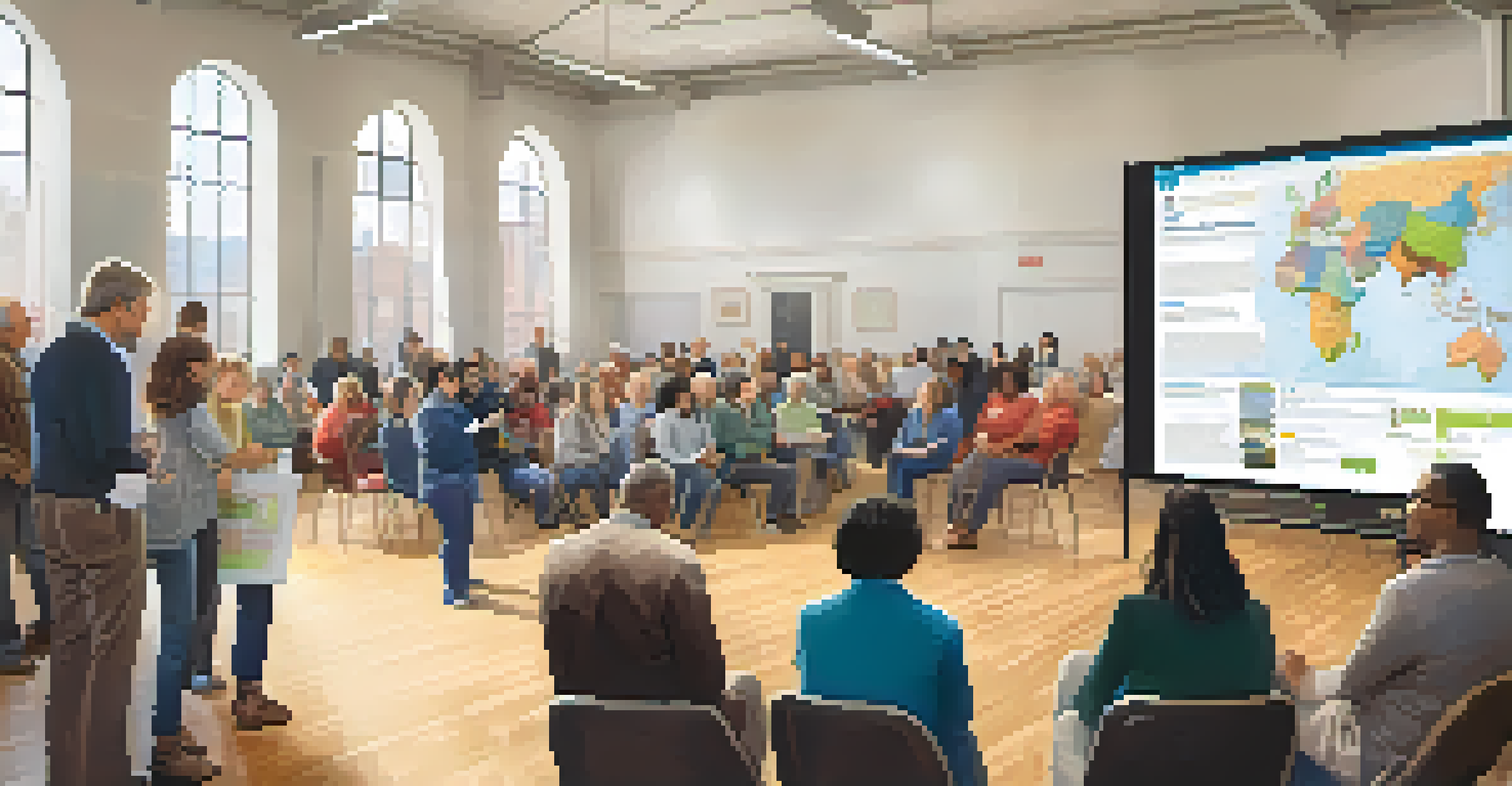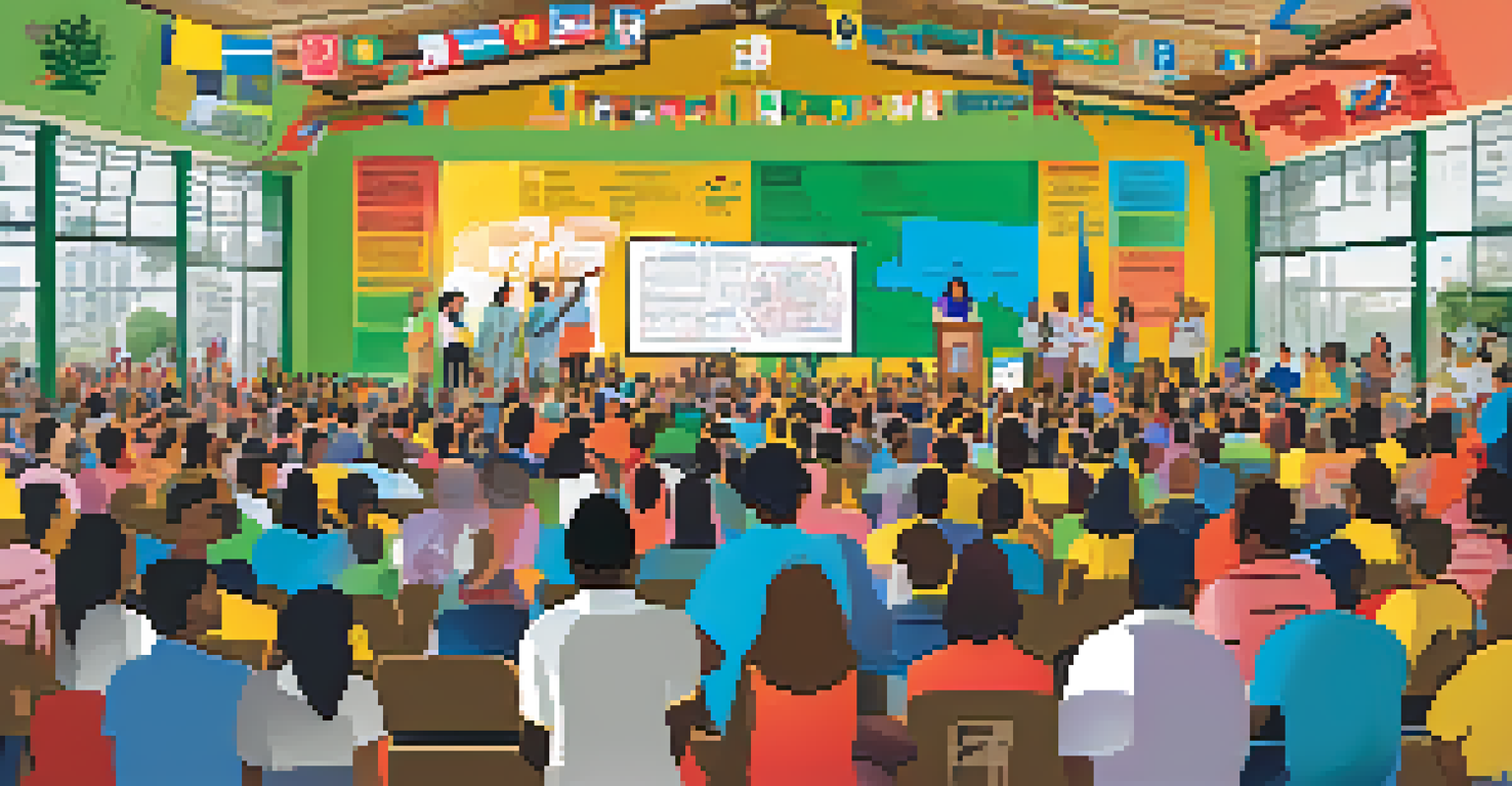Lessons from Global Cities: Public Engagement in Urban Planning

The Importance of Public Engagement in Urban Planning
Public engagement in urban planning is crucial for creating spaces that reflect the needs of the community. When residents are involved in the planning process, they contribute valuable insights that can lead to more effective solutions. This collaboration not only empowers citizens but also fosters a sense of ownership and pride in their neighborhoods.
The best way to predict the future is to create it.
Take, for instance, the city of Barcelona, where citizen input has significantly influenced urban design. By involving residents in discussions about public spaces, Barcelona has successfully transformed its urban landscape to be more inclusive and accessible. This approach highlights how public engagement can lead to innovative ideas that might otherwise be overlooked.
Ultimately, when cities prioritize public engagement, they create environments that are not only functional but also vibrant and reflective of the community's identity. This involvement is essential for fostering trust between planners and residents, ensuring that everyone feels heard and valued.
Case Study: Participatory Budgeting in Porto Alegre
Porto Alegre, Brazil, is often cited as a pioneering example of participatory budgeting, where citizens directly influence how public funds are spent. This initiative began in the late 1980s, allowing residents to propose and vote on local projects. The outcome has been a more equitable distribution of resources, addressing the needs of underserved communities.

In this model, community members gather in assemblies to discuss their priorities, creating transparency in the budgeting process. By giving citizens a voice, Porto Alegre has not only improved public services but also strengthened civic engagement. This case exemplifies how empowering residents leads to better decision-making and enhanced community trust.
Public Engagement Empowers Communities
Involving residents in urban planning fosters a sense of ownership and leads to solutions that better reflect community needs.
As a result, Porto Alegre's participatory budgeting has inspired other cities worldwide to adopt similar practices. This approach demonstrates that when residents are at the forefront of financial decisions, the outcomes are more aligned with the community's actual needs.
Technology's Role in Enhancing Public Engagement
In today's digital age, technology plays a vital role in facilitating public engagement in urban planning. Online platforms and social media allow residents to voice their opinions and participate in discussions from the comfort of their homes. This accessibility has opened the door for a wider range of voices, including those who might feel marginalized in traditional settings.
Public participation is a cornerstone of democracy.
Cities like New York have embraced technology to engage residents through interactive mapping tools and virtual town halls. These initiatives not only make participation more convenient but also enable planners to gather real-time feedback. Such innovative approaches help ensure that urban development aligns with community aspirations.
However, it’s important to remember that while technology can enhance engagement, it shouldn’t replace face-to-face interactions. A balanced approach that combines digital tools with in-person meetings can create a more inclusive environment for all community members.
Engaging Diverse Communities: Best Practices
Engaging diverse communities in urban planning requires a thoughtful approach that recognizes varying cultural backgrounds and needs. Cities must prioritize inclusivity by actively reaching out to underrepresented groups, ensuring their voices are heard. This can be achieved through targeted outreach, multilingual materials, and culturally relevant forums.
For example, Los Angeles has implemented strategies to engage immigrant communities by offering translation services and hosting events in various neighborhoods. This initiative has resulted in more comprehensive feedback, allowing planners to create spaces that cater to all residents. Such practices not only enhance community satisfaction but also foster social cohesion.
Technology Enhances Participation
Digital tools and platforms make it easier for diverse voices to engage in planning discussions, though in-person interactions remain important.
Ultimately, when urban planners embrace diversity, they create environments that reflect the rich tapestry of the community. This inclusivity leads to more sustainable and vibrant urban spaces, benefiting everyone.
Balancing Local Needs with Global Trends
Urban planners face the challenging task of balancing local community needs with broader global trends. As cities evolve, they must navigate issues such as climate change, economic shifts, and technological advancements while considering residents' voices. This balancing act is essential for creating resilient urban environments that serve both current and future generations.
For instance, cities like Copenhagen have integrated sustainability into their urban planning while actively involving citizens in the process. By prioritizing local input on green initiatives, they’ve successfully created eco-friendly spaces that resonate with the community. This approach illustrates how local engagement can inform and shape global strategies.
Furthermore, cities that successfully blend local needs with global trends often become models for others to follow. By championing community involvement in the face of broader challenges, urban planners can create innovative solutions that inspire change across the globe.
Challenges in Public Engagement and Overcoming Them
While public engagement in urban planning is essential, it’s not without its challenges. Common obstacles include apathy, lack of awareness, and barriers to participation, such as timing and location of meetings. Addressing these issues is critical to ensuring meaningful engagement from all community members.
To overcome these challenges, cities can implement various strategies, such as flexible meeting times, remote participation options, and informative campaigns to raise awareness. For example, by utilizing pop-up engagement events in popular areas, planners can reach a broader audience and encourage participation. This proactive approach helps demystify the planning process and invites more residents to share their insights.
Inclusivity Drives Urban Success
Engaging underrepresented communities through targeted outreach creates more equitable and vibrant urban spaces.
By acknowledging and addressing these challenges, urban planners can create a more inclusive environment for public engagement. This commitment fosters a stronger connection between planners and the community, ultimately leading to better urban outcomes.
The Future of Public Engagement in Urban Planning
As cities continue to grow and evolve, the future of public engagement in urban planning looks promising. With advancements in technology and an increasing emphasis on community participation, planners have more tools than ever to involve residents. This shift toward more collaborative approaches is reshaping how urban spaces are designed and developed.
Moreover, the growing awareness of social issues and environmental sustainability is driving cities to prioritize community voices. As more residents demand a say in the planning process, urban planners must adapt to these expectations. This evolution presents an exciting opportunity to create urban environments that truly reflect the desires and needs of the community.

Ultimately, the future of public engagement will likely be characterized by stronger partnerships between planners and residents. By embracing innovation and fostering meaningful dialogue, cities can work towards inclusive, sustainable, and vibrant urban spaces for generations to come.